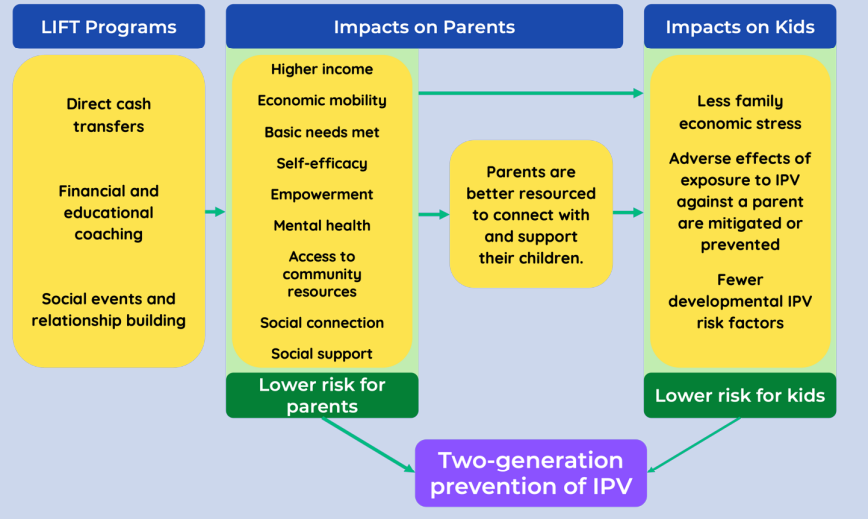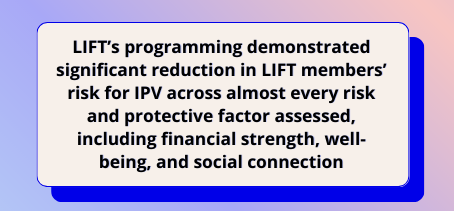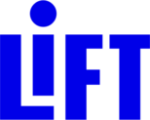New report is the first of its kind that assesses whether an intervention involving economic and social supports for parents can prevent future IPV for both parents AND their children
The following press release and report discuss intimate partner violence, domestic abuse, and their intergenerational nature. Specific descriptions, images, or stories will not be discussed. For additional support, please call the National Domestic Violence Hotline at (800) 799-7233 or reach out to a trained advocate here.
A new report has found that LIFT’s model of cash transfers, economic mobility coaching, and events that build social connection is a promising, evidence-informed approach for preventing intimate partner violence (IPV) across two generations: for LIFT members AND for their children.

This report, commissioned by LIFT-Los Angeles and funded by Blue Shield of California Foundation, is the first to examine how LIFT’s programming and Theory of Change can contribute to preventing IPV. LIFT’s approach is novel in the IPV prevention field, but its Theory of Change aligns well with the existing evidence about why IPV happens and how to prevent it. Economic stress and social isolation, two key focuses of LIFT’s work, are critical influences that increase people’s risk of experiencing IPV. Even worse, experiencing IPV compounds economic stress and social isolation, creating a cycle of vulnerability for survivors. Witnessing IPV against a parent or caregiver is also an important risk factor among children and youths for experiencing IPV later in life, making IPV an intergenerational issue.
Despite the clear evidence about intergenerational cycles of IPV and the importance of economic stability and social connection for preventing IPV, this report is the first the authors could identify that assesses whether an intervention involving economic and social supports for parents can prevent future IPV for both parents and their children.
The CDC names strengthening economic supports for parents as a key approach in preventing adverse childhood experiences. This report adds to a growing body of research showing that early interventions against financial hardships and economic stressors for low-income families can have lasting positive effects on the health and well-being of parents and children.

“We believe that to advance economic mobility, we must focus on advocating for new policies and practices, build out innovative tools, and create new narratives that debunk the myths of those who are
living in poverty. Two-gen approaches are the most effective way to impact a family’s economic trajectory, and LIFT’s model of economic mobility coaching, unrestricted cash transfers, social connection, and well-being supports can address social determinants of health,” says LIFT CEO Michelle Rhone-Collins. “Our program implements a responsive, holistic, family-centered mindset that identifies the factors that undermine a family’s overall well-being and then works directly with parents to address problems, uplifting their children in the process. The intergenerational effects of IPV call for intergenerational interventions, and that’s exactly what our model provides.”
The literature and research from this report found that annual household income was the single most important predictor of risk for IPV for white, Black and Latinx couples. In analyzing the intergenerational impacts of IPV on children, researchers found that there is a strong consensus that witnessing or being exposed to parental IPV as a child has a low to moderate positive association with risk of experiencing or perpetrating IPV later in life. Additional consequences of exposure to IPV in childhood include an increased risk for depression, conduct disorders, and acceptance of IPV, which are all direct risk factors for IPV in adulthood.
With this information, researchers matched questions from LIFT’s wellbeing survey, which members complete every three months, with related risk and protective factors for IPV and found that LIFT’s programming demonstrated significant reduction in LIFT members’ risk for IPV across almost every risk and protective factor assessed, including financial strength, well-being, and social connection.
“The research from this report suggests that the LIFT model helps members’ children both directly (e.g., by reducing family economic stress), and indirectly, by ensuring parents have the social, financial, mental, and emotional resources to mitigate the impacts of exposure to IPV on their children. LIFT’s approach can help parents avoid IPV, whether that’s preventing first-time experiences of violence or preventing further violence among parents who are survivors,” said report authors Deena Fulton, MPH and Raye Dooley, MPH, MSW, LCSW.
These findings point to three important next steps. First, LIFT can provide training and technical assistance to the IPV prevention and response field to help them learn and adopt LIFT’s Theory of Change and program model. Second, LIFT can expand program evaluation to directly assess more risk and protective factors and outcomes related to IPV prevention and disseminate the findings widely. Third, LIFT can ensure that coaches have the training, resources, and connections to community partners to support members who are IPV survivors.
“LIFT believes that we can, and we must, create a safety net where we hold those who are most vulnerable at the center. We see a path forward that will leverage LIFT’s coaching model to change systems practice at scale and infuse holistic economic coaching into large systems,” says Elena Pinzon O’Quinn, MPH, LIFT Learning and Evaluation Director. “We know from decades of research on the social determinants of health that poverty has long-term physical health and well-being consequences, especially when financial hardship is experienced in early childhood. But while the impacts of adverse childhood experiences can be long-lasting, this report shows they don’t have to be–we have the tools to help children thrive and prevent the cycle of poverty and violence.”
Because of these positive research results in LA, LIFT expanded data analysis to all LIFT sites to add to the growing evidence that LIFT’s model can ensure that parents have the social, financial, mental, and emotional resources to mitigate the impacts of exposure to IPV on their children. The expanded national analysis showed the same significant improvements
Learn more about the key findings of the report from the lead authors and explore with an esteemed panel of experts how LIFT’s programming model can have a unique contribution to the field of intimate partner violence prevention by watching the recording of the first webinar in LIFT’s Upstream Interventions Series: LIFT’s Model and Two-Generation Prevention of Intimate Partner Violence.
For further information or questions concerning the report, LIFT’s work in two-generation prevention, or how we can collaborate on future projects please contact our Chief Program & Strategy Officer, Helah Robinson at [email protected].
The authors of this report are Deena Fulton, MPH of D. Fulton Consulting and Raye Dooley, MSW, MPH of Whole Being Therapy.
